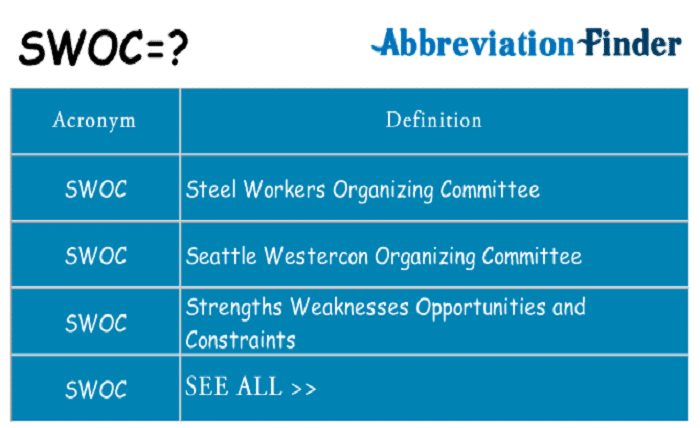SWOC Full Form: Understanding the Meaning and Application

Are you curious about the term “SWOC” and its significance? In this article, we will delve into the full form of SWOC and explore its meaning and application in different contexts. From its origins to its relevance in various fields, we’ll cover it all. So let’s get started!SWOC is an acronym that represents a strategic planning and analysis tool used in various domains. By examining the strengths, weaknesses, opportunities, and challenges of a particular situation or entity, SWOC analysis provides valuable insights for decision-making and strategic planning.
What is SWOC?
SWOC stands for Strengths, Weaknesses, Opportunities, and Challenges. It is an extension of the more well-known SWOT (Strengths, Weaknesses, Opportunities, and Threats) analysis, with the “T” (Threats) replaced by “C” (Challenges). SWOC analysis helps individuals and organizations evaluate their internal factors (strengths and weaknesses) and external factors (opportunities and challenges) to gain a comprehensive understanding of their current situation.
Understanding the Components of SWOC
Let’s dive deeper into each component of SWOC:
Strengths (S)
Strengths refer to the positive attributes and resources an individual or organization possesses. These can include skills, knowledge, assets, reputation, or any other factors that provide a competitive advantage.
Weaknesses (W)
Weaknesses represent the areas where an individual or organization lacks strength or is vulnerable. These can be internal factors such as limited resources, skill gaps, or other aspects that hinder progress.
Read more about sdfxglobal
Opportunities (O)
Opportunities are external factors that have the potential to bring positive outcomes. These can include emerging trends, market developments, technological advancements, or any favorable circumstances that can be leveraged for growth.
Challenges (C)
Challenges encompass the external factors that pose obstacles or threats to an individual or organization. These can be market competition, changing regulations, economic downturns, or any other factors that need to be addressed and managed effectively.
SWOC Analysis: A Strategic Planning Tool
SWOC analysis provides a structured framework for evaluating the internal and external factors affecting a situation. By conducting a SWOC analysis, individuals and organizations can gain a comprehensive understanding of their current position and make informed decisions.
SWOC in Business Management
In the realm of business management, SWOC analysis plays a vital role in strategic planning, market research, and competitive analysis. It helps identify areas of improvement, capitalize on opportunities, mitigate risks, and stay ahead of the competition.
SWOC in Education
In the field of education, SWOC analysis is employed to assess the strengths and weaknesses of educational institutions, develop strategies for improvement, identify opportunities for growth, and overcome challenges in the ever-evolving educational landscape.
SWOC in Personal Development
On an individual level, SWOC analysis can be a powerful tool for personal development. By evaluating strengths, weaknesses, opportunities, and challenges, individuals can identify areas for personal growth, capitalize on opportunities for self-improvement, and address any obstacles hindering their progress.
Examples of SWOC Analysis
Here are a few examples of how SWOC analysis can be applied in different scenarios:
- Business Example: A new startup conducts a SWOC analysis to identify its competitive advantages (strengths), areas needing improvement (weaknesses), market trends to leverage (opportunities), and potential challenges it may face (challenges).
- Educational Example: A university conducts a SWOC analysis to assess its faculty’s strengths, areas of curriculum improvement, emerging educational technologies to adopt, and external factors such as changing student demographics.
How to Conduct a SWOC Analysis
To conduct a SWOC analysis, follow these steps:
- Identify the entity or situation for analysis.
- Make a list of strengths, weaknesses, opportunities, and challenges relevant to the entity.
- Prioritize and categorize the identified factors.
- Analyze each factor and determine its impact on the entity.
- Develop strategies and action plans based on the analysis.
Advantages and Limitations of SWOC
SWOC analysis offers several advantages, including:
- Comprehensive evaluation of internal and external factors.
- Identifying opportunities for growth and improvement.
- Enhanced decision-making and strategic planning.
However, it’s important to consider the limitations of SWOC analysis:
- Subjectivity in identifying and prioritizing factors.
- Lack of quantitative analysis.
- Dynamic nature of factors requiring regular reassessment.
Conclusion
SWOC (Strengths, Weaknesses, Opportunities, and Challenges) is a valuable strategic planning tool used across various domains. By conducting a SWOC analysis, individuals and organizations can gain insights into their current situation, identify areas for improvement, capitalize on opportunities, and effectively address challenges. Remember, SWOC analysis is an ongoing process that requires periodic review and adaptation to ensure its relevance and effectiveness.



